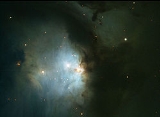
Messier 78
Encyclopedia
The nebula Messier 78 (also known as M 78 or NGC 2068) is a reflection nebula
in the constellation
Orion
. It was discovered by Pierre Méchain
in 1780 and included by Charles Messier
in his catalog of comet
-like objects that same year.
M78 is the brightest diffuse reflection nebula of a group of nebulae that include NGC 2064, NGC 2067 and NGC 2071. This group belongs to the Orion Molecular Cloud Complex
and is about 1,600 light years distant from Earth
. M78 is easily found in small telescope
s as a hazy patch and involves two star
s of 10th magnitude
. These two stars, HD 38563A and HD 38563B, are responsible for making the cloud of dust in M78 visible by reflecting their light.
About 45 variable star
s of the T Tauri type, young stars still in the process of formation as well as some 17 Herbig-Haro object
s are known in M78.
Reflection nebula
In Astronomy, reflection nebulae are clouds of dust which are simply reflecting the light of a nearby star or stars. The energy from the nearby star, or stars, is insufficient to ionize the gas of the nebula to create an emission nebula, but is enough to give sufficient scattering to make the dust...
in the constellation
Constellation
In modern astronomy, a constellation is an internationally defined area of the celestial sphere. These areas are grouped around asterisms, patterns formed by prominent stars within apparent proximity to one another on Earth's night sky....
Orion
Orion (constellation)
Orion, often referred to as The Hunter, is a prominent constellation located on the celestial equator and visible throughout the world. It is one of the most conspicuous, and most recognizable constellations in the night sky...
. It was discovered by Pierre Méchain
Pierre Méchain
Pierre François André Méchain was a French astronomer and surveyor who, with Charles Messier, was a major contributor to the early study of deep sky objects and comets.-Life:...
in 1780 and included by Charles Messier
Charles Messier
Charles Messier was a French astronomer most notable for publishing an astronomical catalogue consisting of deep sky objects such as nebulae and star clusters that came to be known as the 110 "Messier objects"...
in his catalog of comet
Comet
A comet is an icy small Solar System body that, when close enough to the Sun, displays a visible coma and sometimes also a tail. These phenomena are both due to the effects of solar radiation and the solar wind upon the nucleus of the comet...
-like objects that same year.
M78 is the brightest diffuse reflection nebula of a group of nebulae that include NGC 2064, NGC 2067 and NGC 2071. This group belongs to the Orion Molecular Cloud Complex
Orion Molecular Cloud Complex
The Orion Molecular Cloud Complex refers to a large group of bright nebula, dark clouds, and young stars located in the constellation of Orion. The cloud itself is between 1,500 and 1,600 light-years away and is hundreds of light-years across...
and is about 1,600 light years distant from Earth
Earth
Earth is the third planet from the Sun, and the densest and fifth-largest of the eight planets in the Solar System. It is also the largest of the Solar System's four terrestrial planets...
. M78 is easily found in small telescope
Telescope
A telescope is an instrument that aids in the observation of remote objects by collecting electromagnetic radiation . The first known practical telescopes were invented in the Netherlands at the beginning of the 1600s , using glass lenses...
s as a hazy patch and involves two star
Star
A star is a massive, luminous sphere of plasma held together by gravity. At the end of its lifetime, a star can also contain a proportion of degenerate matter. The nearest star to Earth is the Sun, which is the source of most of the energy on Earth...
s of 10th magnitude
Apparent magnitude
The apparent magnitude of a celestial body is a measure of its brightness as seen by an observer on Earth, adjusted to the value it would have in the absence of the atmosphere...
. These two stars, HD 38563A and HD 38563B, are responsible for making the cloud of dust in M78 visible by reflecting their light.
About 45 variable star
Variable star
A star is classified as variable if its apparent magnitude as seen from Earth changes over time, whether the changes are due to variations in the star's actual luminosity, or to variations in the amount of the star's light that is blocked from reaching Earth...
s of the T Tauri type, young stars still in the process of formation as well as some 17 Herbig-Haro object
Herbig-Haro object
Herbig–Haro objects are small patches of nebulosity associated with newly born stars, and are formed when gas ejected by young stars collides with clouds of gas and dust nearby at speeds of several hundred kilometres per second...
s are known in M78.
External links
- Messier 78, SEDS Messier pages
- M78: Stardust and Starlight
- NightSkyInfo.com - M78
- Astronomy Picture of the DayAstronomy Picture of the DayAstronomy Picture of the Day is a website provided by NASA and Michigan Technological University . According to the website, "Each day a different image or photograph of our universe is featured, along with a brief explanation written by a professional astronomer."The photograph is not necessarily...
- M78 Wide Field 2009 November 26
- M78 and Reflecting Dust Clouds in Orion 2010 March 2

